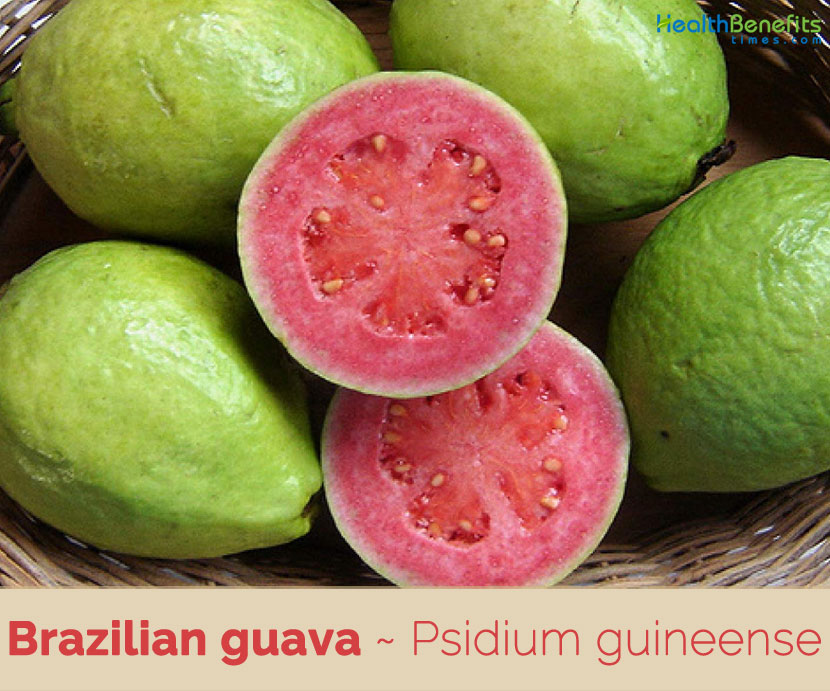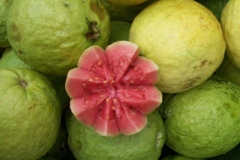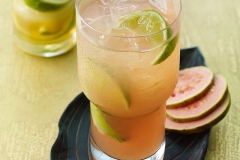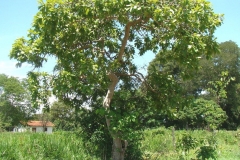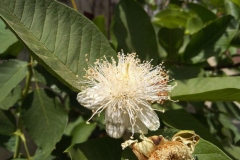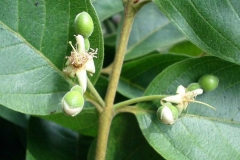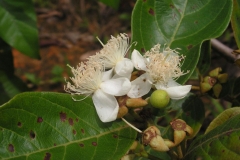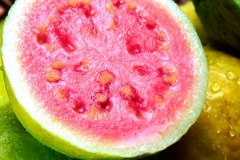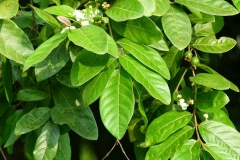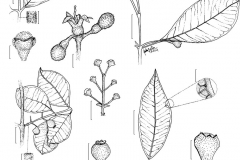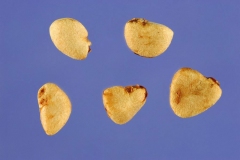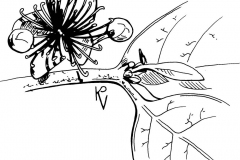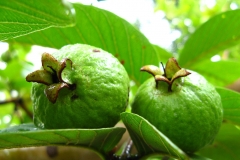| Brazilian guava Quick Facts |
| Name: |
Brazilian guava |
| Scientific Name: |
Psidium guineense |
| Origin |
American tropics and sub-tropics, occurring naturally from northern Argentina and Peru to southern Mexico |
| Colors |
Green turning to yellow when mature |
| Shapes |
Ellipsoid to globose, 1.5– 2.5 cm wide with persistent calyx |
| Flesh colors |
Reddish white flesh |
| Taste |
Tart, strawberry-like taste |
| Health benefits |
Tougher Bones, Lowered Blood Pressure, Stronger Immunity, Better Eyesight, Lovelier Skin |
Botanically known as Psidium guineense, the Brazilian guava is also known as guayaba brava, goiaba in Portuguese and Castilian guava in California. Psidium guineense is a species of guava belonging to Myrtle family Myrtaceae. The Brazilian guava is considered a “tropical guava” as it is native to the tropics and grows year-round in those areas. The plant is native to American tropics and sub-tropics, occurring naturally from northern Argentina and Peru to southern Mexico, and in the Caribbean – Trinidad, Martinique, Jamaica and Cuba. It is cultivated to a limited extent in Martinique, Guadeloupe, the Dominican Republic and southern California. Apart from Brazilian guava it is also known as Castilian Guava, Guinea Guava, Güisara Guava, Guisaro Sour Guava, Wild Guava and sour guava.
Brazilian guavas may be small in size (they are usually no larger than golf balls) but they are big in health benefits. Just like regular guavas, these tropical treats are phenomenal sources of vitamin C. Indeed, their addition to your diet on a regular basis can make your body less vulnerable to disease-causing microbes. Commonly, Brazilian guavas are consumed as they are, their fleshy pulp with very hard tiny seeds often scooped out with a spoon. However, they are also used for baking and turned into jams and jellies. In Brazil, they are made into a paste called “goiabada” which is exported to neighboring countries.
Plant Description
Brazilian guava is a relatively slow-growing, evergreen erect shrub or small tree that grows about 1.5–6 m high with smooth, greyish bark, hairy young shoots and cylindrical branchlets. The plant is found growing in disturbed areas, such as old pastures, abandoned agricultural areas along roadsides, wet to dry thickets, open forest, often in oak or pine forest, frequently on rocky open hillsides or plains. The plant prefers wide range of soil types but does best on well-drained, moist, fertile loamy soils up to medium elevations. It tolerates poor soils such as light-textured sandy soils but abhors water-logged and saline soils.
Leaves
The evergreen, greyish leaves, 3.5-14 cm long and 2.5-8 cm wide, are stiff, oblong, elliptic, ovate (egg-shaped with broad end at base) or obovate (egg-shaped leaf with the narrower end at the base), sometimes finely toothed; scantily hairy on the upper side but coated beneath with pale or rusty hairs and distinctly dotted with glands.
Flower
Flowers are white, regular, and bisexual, borne singly or in clusters of three in the axils of leaf on 1–2.5 cm long terete pedicels. Calyx is splitting into irregular, pubescent, pale green lobes, corolla with five white spreading concave obovate lobes, stamens numerous 150- with bilocular anthers, ovary ellipsoid to globose, three to five locular with numerous ovules and style subulate.
Fruit
Fertile flowers are followed by round or pear-shaped fruit 1.5– 2.5 cm wide, with persistent calyx. The fruit is initially green turning to yellow when mature with pale-yellowish-white flesh and numerous small, hard, kidney-shaped, flattened seeds 5–8 mm diameter. Fruit has acid, resinous, slightly strawberry-like flavor.
Health benefits of Brazilian Guava
Let us check out some of the most amazing bonuses that you may obtain from consuming these highly nutritious tropical fruits on a regular basis
1. Tougher Bones
You can also obtain decent amounts of calcium in every serving of Brazilian guava. In other words, consuming these tropical fruits can help in lowering your risk of having osteoporosis due to the fact that they help in making your bones strong. Regularly eat calcium-containing Brazilian guavas because their calcium as well as vitamin C content is good for keeping your teeth and gums healthy and strong.
2. Lowered Blood Pressure
Brazilian guavas consist of good amount of potassium. According to medical experts, potassium is vital for keeping high blood pressure at bay. It’s because the said mineral has vaso-dilating properties. It can cause the blood vessels to widen. As a result, blood can flow through them without any trouble. Keeping your blood pressure normal, experts say, can help in lowering your risk of ending up with cardiovascular disease.
3. Stronger Immunity
Brazilian guavas are extremely rich in vitamin C. This is exactly the reason why its addition in your diet regularly can help in bolstering your immune system, something that’s authoritative most especially when the flu season is about to arrive or is already going on. Consuming vitamin C-rich Brazilian guavas enables your body to be able to defend itself against those invading microbes that can cause a variety of problems.
4. Better Eyesight
Another vitamin that you can obtain from Brazilian guavas is vitamin A. Just like vitamin C, it’s actually a powerful type of antioxidant. However, vitamin A is more associated with the maintenance of healthy eyes. By regularly adding Brazilian guavas and other vitamin A-rich foods to your diet, it can become easier to dodge glaucoma, cataracts and other eye problems that can lead to loss of vision if not properly managed or put under control.
5. Lovelier Skin
Vitamin C found in abundance in Brazilian guavas is also important for making your skin look beautiful and youthful. That’s because it is actually an antioxidant that destroys free radicals before they damage healthy skin cells. What’s more, vitamin C is essential in the production of collagen, which is a type of protein that your skin needs to remain elastic. As a result, it becomes less susceptible to wrinkling as the years pass by.
https://www.youtube.com/watch?v=8ShMBHJubAk
Traditional uses and benefits of Brazilian guava
- Psidium guineense is used in treating diarrhea in Argentinean traditional medicine
- Decoction of the bark or roots is used to treat urinary diseases, diarrhea and dysentery and is considered to be diuretic in interior of Brazil.
- Decoction is said to reduce varicose veins and ulcers on the legs in Costa Rica.
- Leaf decoction is taken to relieve colds and bronchitis.
- Extracts of the leaves are used to ease the common cold in Costa Rica.
- Juice of the young fruit is squeezed and used as a treatment for dysentery and upset stomachs.
Culinary Uses
- This fruit is sub acid and is suitable for baking, jams, preserves, juices and sweets although the sweeter varieties may be eaten out of hand.
- It can be processed into a distinctive jelly which is more flavorsome than guava jelly.
- Pectin rich fruit is commonly used for baking and for preservation of Jelly.
- It can also be found in salads and fruit salads.
Other facts
- Wood is strong and resistant and is used for tool handles, beams, posts, planks, utensil and agricultural instruments.
- It is also used for firewood and charcoal.
- The bark, rich in tannin, is used for curing hides.
- Since bark is rich in tannin it is used in tanning.
References:
https://www.itis.gov/servlet/SingleRpt/SingleRpt?search_topic=TSN&search_value=506172#null
https://davesgarden.com/guides/pf/go/166190/
http://www.hear.org/pier/species/psidium_guineense.htm
https://keys.lucidcentral.org/keys/v3/eafrinet/weeds/key/weeds/Media/Html/Psidium_guineense_(Brazilian_Guava).htm
https://plants.usda.gov/core/profile?symbol=PSGU3
https://en.wikipedia.org/wiki/Psidium_guineense
https://bie.ala.org.au/species/http://id.biodiversity.org.au/node/apni/2918696
https://npgsweb.ars-grin.gov/gringlobal/taxonomydetail.aspx?30208
http://www.theplantlist.org/tpl1.1/record/kew-166748
https://hort.purdue.edu/newcrop/morton/brazilian_guava_ars.html
http://tropical.theferns.info/viewtropical.php?id=Psidium+guineense
https://gd.eppo.int/taxon/PSIGN
https://www.cabi.org/isc/datasheet/45139
http://swbiodiversity.org/seinet/taxa/index.php?taxon=Psidium+guineense
Comments
comments


